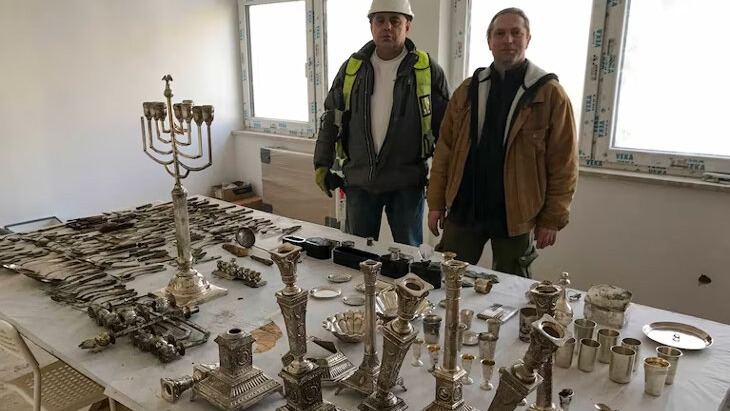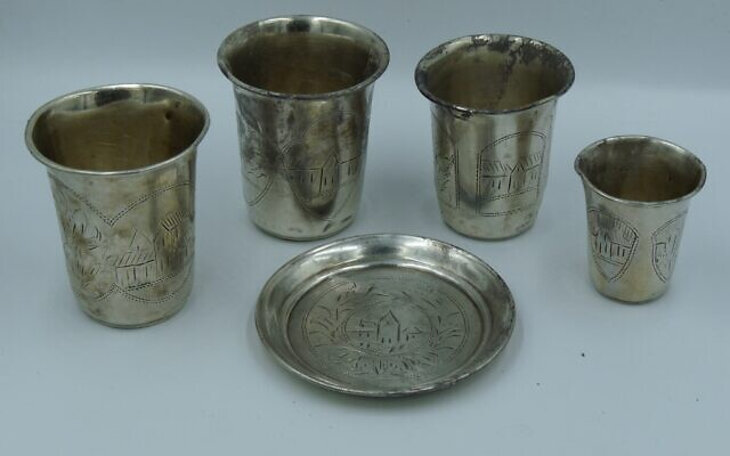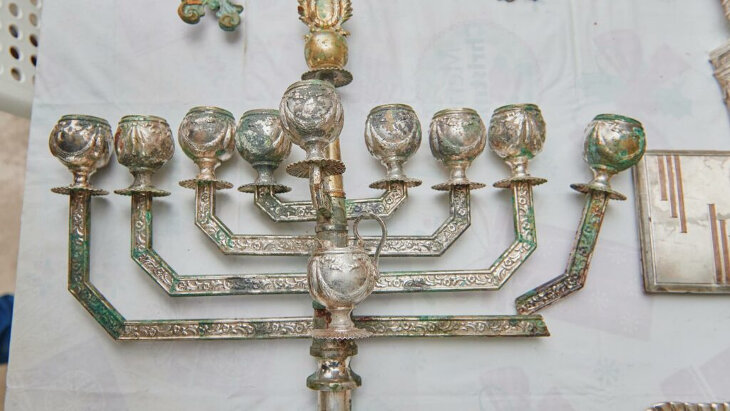 Vampire Weekend's Surprising Jewish Stories
Vampire Weekend's Surprising Jewish Stories


6 min read
Polish workers unearthed a box containing hundreds of Jewish treasures from the Holocaust.
23 Polnocna Street in the central Polish city of Lodz is a rundown apartment building, one in a long row of pre-war buildings on a cobblestone street. A shocking discovery in December 2022 shed light on the building’s vibrant Jewish history.
Builders working on a renovation project unearthed a large wooden box buried in the yard behind the building. They found a virtual treasure trove: over 400 silver objects, including Kiddush cups, menorahs, Shabbat candlesticks, silverware, as well as some glass cosmetic containers, all packed in old newspapers.

There was no note, no instructions of where to send the items or any indication of who their owners might have been. “Those residents who buried these items did so most likely thinking that they would one day return for them, that they would be able to retrieve them,” Lodz’s Deputy Mayor Adam Pustelnik explained to reporters.
The items once graced the homes of Jews who seemingly hastily buried them in the early days of World War II. Looking at them, it’s almost possible to imagine the warm family scenes that played out during beautiful Shabbat dinners when these Shabbat candlesticks glowed with light and the Kiddush cups and cutlery helped make families’ Shabbat dinners warm and special.
For hundreds of years, Lodz was home to one of the world's largest Jewish communities. On the eve of World War II, Lodz – Poland’s third largest city – was an intensely Jewish place. About a third of its 1939 population of nearly 700,000 were Jews. Jewish schools, synagogues, youth groups, charities and clubs created a vibrant cultural and religious life. The city was home to Yiddish theaters and newspapers, and other Jewish periodicals printed in Polish and Hebrew. Chassidic Jews, secular Jews, idealistic Zionists all called Lodz home. The first Polish language Jewish high school was located there, as were yeshivas that taught in Yiddish, and Zionist training centers where the language was Hebrew. There was even an early kibbutz – Jewish communal farm – where Jews practiced farming skills before moving to the Land of Israel.
Life wasn’t easy. Lodz Jews realized that they were barely tolerated by their Polish neighbors.
 Silver cups found under a Lodz apartment building
Silver cups found under a Lodz apartment building
https://aish.com/wp-content/uploads/2023/01/Polish-Builders-Find-400-Buried-Jewish-Items730.jpg
The city was devastated during the First World War, and in the aftermath, government programs helped non-Jewish residents rebuild – while ignoring the Jewish owned sectors in the city, particularly textiles, which was seen as a “Jewish” industry at the time. In the 1930s, antisemitism reached sky-high levels and attacks on Jews became common. Still, the Jews of Lodz managed to flourish, maintaining their Jewish lifestyle and beliefs in the face of rising hatred.
Soon after Germany invaded Poland in September, 1939, they started planning a Jewish ghetto in the northeastern part of the city. The border of the ghetto ran very near 23 Polocna Street, where the box was buried.
Starting in 1940, Jews from the rest of the city and areas as far away as Vienna, Luxembourg and Prague were systematically moved into the Lodz ghetto, ordered to pack a few items hastily and move to the designated area. Eventually, 230,000 Jews would be confined in a fenced off area measuring 1.5 square miles, as well as 5,000 Gypsies in a nearby subcamp. The ghetto was sealed off from the rest of the city by barbed wire fences.
 Sara Plagier
Sara Plagier
There are many records of life in the ghetto. “In the ghetto we had no need for a calendar,” wrote one young girls in the ghetto, Sara Plagier, age 14. “Our lives were divided into periods based on the distribution of food: bread every eighth day, the ration once a month. Each day fell into two parts: before and after we received our soup. In this way the time passed.”
A bar mitzvah boy, Chaim Kozienicki, who was imprisoned in the ghetto, wrote: “The day of my Bar Mitzvah arrived. I put on the tefillin and I said the blessings. As a gift from my family I received half a loaf of bread. They wanted me to eat it right there and then, in their presence. I refused. I couldn’t even imagine for how long they saved it from themselves in order to give it to me. They decided that I had to eat it, and I ate it. I couldn’t look them in the eye because I ate their bread.”
Conditions inside the ghetto were appalling. There was no electricity or running water in the ghetto. Lodz was meant to be a “model” ghetto where Jews could prove their worth by toiling in German owned factories, in primitive conditions. Even young children worked as slave laborers. Tens of thousands of Jews died from starvation and disease.

In 1942, the Nazis began deporting Jews from the ghetto to the nearby Chelmno death camp. The ghetto was “liquidated” in 1944 by the Nazi forces, when the remaining 60,000 Jewish residents were sent to Auschwitz and murdered. When Soviet forces entered the ghetto in 1945, they found 877 Jews alive there.
We’ll never know who stowed their family heirlooms at 23 Polnocna Street, just outside the ghetto’s walls. The mothers who lit candles each week in the buried silver candlesticks, the fathers who made Kiddush for their families and the children who gathered around their family tables were swept away in the horrors of the Lodz ghetto, murdered through slave labor, starvation or gassed in Nazi death camps.
Most of the uncovered artifacts are going to be displayed in Lodz’s Museum of Archaeology and Ethnography. “Most likely, these people lost their lives” in the Holocaust, Lodz’s Deputy Mayor explained. “Such stories are truly rare and precious and also are a great lesson for us all.”
 A menorah found under a Lodz apartment building, January 3, 2022. (Facebook/Provincial Office
A menorah found under a Lodz apartment building, January 3, 2022. (Facebook/Provincial Office
for the Protection of Monuments in Łódz)
Two of the items received new life this past Hanukkah: Lodz’s Jewish community arranged to have two of the menorahs lit publicly, the first time they were used in nearly a century, declaring to the world that after the horrors of the Holocaust, the Jewish community remains.
A few days after reading about this startling find, I prepared to light my own Shabbat candlesticks. They once belonged to my great aunt and were made in Poland before the Holocaust. Lighting them, I thought of the Lodz treasures savoring the privilege to light them and usher the peace of Shabbat into my home. I thought of the hundreds of thousands of Jews who were interred in the Lodz ghetto and were murdered – including my great grandfather. I wondered if one of the Kiddush cups in that box was his, stowed there in a desperate attempt to safeguard one of our family’s beloved items.
Using these precious Judaic items are the greatest tributes we can make to the Jews who buried them, hoping one day to celebrate Shabbat and Jewish holidays with them once more.
